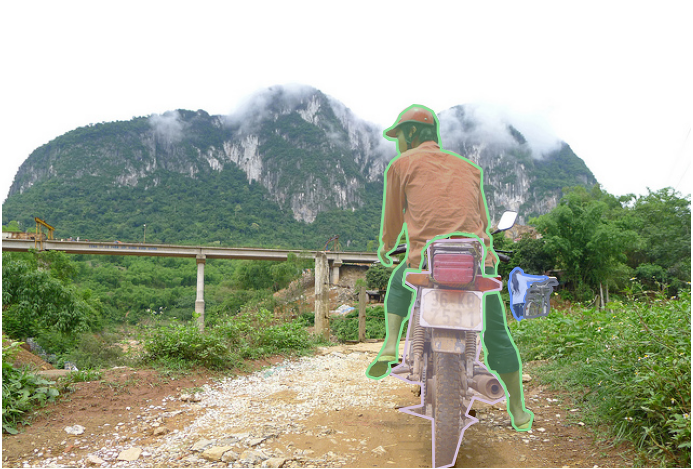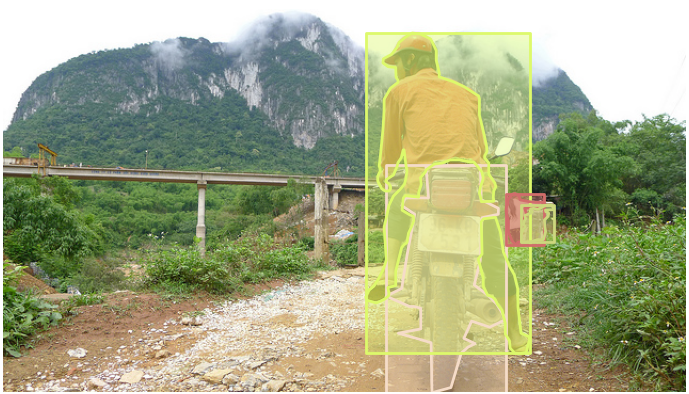preface
好多目标检测论文都用的是 COCO 的数据集,所以代码也是基于 COCO,因为这个数据集本身比较复杂,为了简化研究人员在处理数据集代码上面花费的时间,有个叫做 pycocotools 的 python 包出现了,在很多论文开源代码中大家都是用这个包来进行代码复现的,因此这里就来小小总结一下
首先需要引入这个包,然后创建一个 coco 对象,创建时要将 annotation 的路径传进去
from pycocotools.coco import COCO
coco = COCO('/NAS_REMOTE/PUBLIC/data/coco2017/annotations/instances_train2017.json')
如果直接运行的话就会输出以下 log
loading annotations into memory...
Done (t=15.79s)
creating index...
index created!
创建好了 coco 对象后就可以使用他的一些 API 了,下面列举一些常用的,后续有用到其他的话也会继续更新
getImgIds
coco.getImgIds(imgIds=[], catIds=[]) 可以获取到 coco 所有图片对应的 id 号,以便后续处理,另外,传入 catIds 参数的话也可以只返回特定的类别的图片对应的 id 号,但是 catIds 需要通过其他方式获得,假设我们知道狗的 catId 为 18,我们就可以通过下面代码得到所有有狗的图片的 id 号
coco.getImgIds(catIds=18)
[98304, 204800, 524291, 311301, 491525, 147471, 131087, 278550, 581654, 253981, 450590, 106525, 368676, 253988, …]
getCatIds
getCatIds(catNms=[], supNms=[], catIds=[]) 可以获取到 coco 类别对应的 label 号,因为 coco 有 80 类,所以如果不传入其他参数的话返回的就是一个拥有 80 个元素的列表(不是连续的数字,中间会跳过几个数字
coco.getCatIds()
[1, 2, 3, 4, 5, 6, 7, 8, 9, 10, 11, 13, 14, 15, …]
当然也可以传入类别名字,筛选出特定类别代表的 label ,如下说明 dog 的标签为 18
coco.getCatIds(catNms='dog')
[18]
getAnnIds
getAnnIds(imgIds=[], catIds=[], areaRng=[], iscrowd=None) 获取某图像对应的 annotation 的 id 号,即 groundtruth,以下说明了该图有 4 个 标注
coco.getAnnIds(imgIds=coco.getImgIds()[0])
[151091, 202758, 1260346, 1766676]
loadImgs
loadImgs(ids=[]) 用的时候会在里面加上图片对应的 id 号返回某张图片的信息
coco.loadImgs(ids=coco.getImgIds()[0])
[{‘coco_url’: ‘http://images.cocoda…391895.jpg’, ‘date_captured’: ‘2013-11-14 11:18:45’, ‘file_name’: ‘000000391895.jpg’, ‘flickr_url’: ‘http://farm9.staticf…8349_z.jpg’, ‘height’: 360, ‘id’: 391895, ‘license’: 3, ‘width’: 640}]
loadCats
loadCats(ids=[]) 用法和上面差不多,是通过类别的 label 来返回className
coco.loadCats(ids=18)
[{‘id’: 18, ‘name’: ‘dog’, ‘supercategory’: ‘animal’}]
loadAnns
loadAnns(ids=[]) 用来加载特定 annotation id 号的标注
coco.loadAnns(ids=202758)
[{‘area’: 14107.271300000002, ‘bbox’: […], ‘category_id’: 1, ‘id’: 202758, ‘image_id’: 391895, ‘iscrowd’: 0, ‘segmentation’: […]}]
19.3.2023 更新
这个函数的用途就是,一张图中可能不止一个框/分割标注,我们可以先通过 getAnnIds 得到某张图片中所有的标注的 id,再把 id 传进来就可以得到对应的所有标注信息了。
showAnns
showAnns(anns, draw_bbox=False) 同上,如果获取到了 Anno 信息之后,可以用这个函数直接将 Anno 信息给可视化出来,挺有意思的
dataset_dir = '/NAS_REMOTE/PUBLIC/data/coco2017/train2017/'
coco = COCO(os.path.join('/NAS_REMOTE/PUBLIC/data/coco2017', 'annotations', 'instances_' + 'train2017' + '.json'))
image_ids = coco.getImgIds()
img = coco.loadImgs(image_ids[0])[0]
I = io.imread(dataset_dir + img['file_name'])
plt.axis('off')
plt.imshow(I)
annIds = coco.getAnnIds(imgIds=image_ids[0])
annos = coco.loadAnns(ids=annIds)
coco.showAnns(annos)
plt.show()

还可以在 showAnns 中将 draw_bbox 参数变成 True 来画出 bbox

cats
这个 API 可以直接输出数据集对应的类别(调用的时候不加括号),相当于 json 文件中的 'categories' 关键字,也相当于 loadCats(getCatIds()) 的输出结果
实际应用
PyTorch 中一般将数据集封装为一个类,继承 Dataset 父类,一次返回图像和其 label,其实就是在上述 API 基础上进行一些改动,主要是 loadImgs 和 loadAnns 这两个函数,下面截取 pytorch-retinanet 中的部分代码作为示范
def __getitem__(self, idx):
img = self.load_image(idx)
annot = self.load_annotations(idx)
sample = {'img': img, 'annot': annot}
if self.transform:
sample = self.transform(sample)
return sample
def load_image(self, image_index):
image_info = self.coco.loadImgs(self.image_ids[image_index])[0]
path = os.path.join(self.root_dir, self.set_name, image_info['file_name'])
img = skimage.io.imread(path)
if len(img.shape) == 2:
img = skimage.color.gray2rgb(img)
return img.astype(np.float32)/255.0
def load_annotations(self, image_index):
# get ground truth annotations
annotations_ids = self.coco.getAnnIds(imgIds=self.image_ids[image_index], iscrowd=False)
annotations = np.zeros((0, 5))
# some images appear to miss annotations (like image with id 257034)
if len(annotations_ids) == 0:
return annotations
# parse annotations
coco_annotations = self.coco.loadAnns(annotations_ids)
for idx, a in enumerate(coco_annotations):
# some annotations have basically no width / height, skip them
if a['bbox'][2] < 1 or a['bbox'][3] < 1:
continue
# 4 个 bbox 坐标,一个 id 号
annotation = np.zeros((1, 5))
annotation[0, :4] = a['bbox']
annotation[0, 4] = self.coco_label_to_label(a['category_id'])
annotations = np.append(annotations, annotation, axis=0)
# transform from [x, y, w, h] to [x1, y1, x2, y2]
annotations[:, 2] = annotations[:, 0] + annotations[:, 2]
annotations[:, 3] = annotations[:, 1] + annotations[:, 3]
return annotations
看到一个博客,跟我写的差不多,不过会稍微详细一些,还把 mask 处理之类的 API 也讲了
https://hellozhaozheng.github.io/z_post/%E8%AE%A1%E7%AE%97%E6%9C%BA%E8%A7%86%E8%A7%89-%E6%95%B0%E6%8D%AE%E9%9B%86-COCO/
reference
https://github.com/yhenon/pytorch-retinanet
https://blog.csdn.net/u013832707/article/details/94445495
https://blog.csdn.net/qq_29631521/article/details/103166116